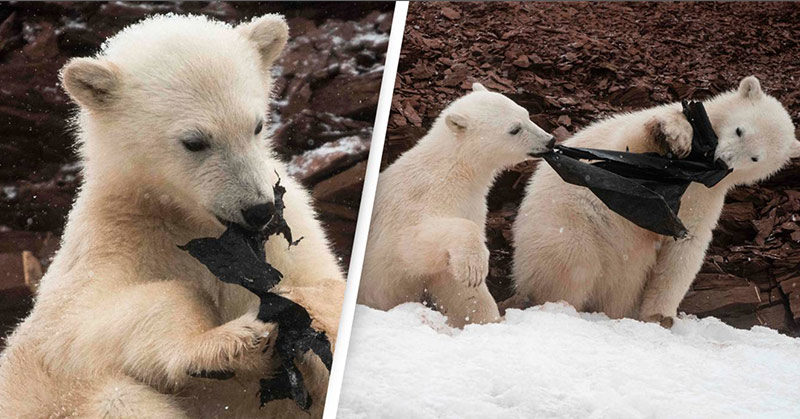Devastating photos have emerged of two polar bear cubs eating a plastic bag they dug up on the shore. Hungry polar bears aren’t the only ones who unintentionally eat plastic waste in the arctic, and this leftover trash is a big problem.
Hungry Polar Bears Eat Plastic Bag
Jens Wikström is an Arctic Expeditions leader from Sweden. Recently he was on an expedition in Lifdefjorden in Svalbard, Norway, when he spotted two young polar bear cubs playing with a black plastic bag. (1)
From a safe distance away, he watched the hungry polar bears dig the bag from the shoreline show. They first began playing with it, ripping it apart like a toy. This lasted about 15 minutes before they finally ate some of it.
He described it as heartbreaking to watch.
“[This is] what happens to our ecosystem when we don’t take care of our sh*t’.” he said. “It ends up in the bellies of these animals.” (1)
He explains that polar bear cubs are naturally very playful animals, and will use almost anything they can get their paws on as a toy.
Not Just Hungry Polar Bears
Wikström goes on to explain how polar bears aren’t the only arctic animals affected by plastic pollution. He has seen other animals, such as arctic foxes, also play with and eat the plastic waste that washes up onshore.
“It’s no secret we have a lot of pollution… I just hope people will think twice before leaving plastic bags or cigarette butts on the ground, you never know where it will end up.” (1)
That garbage arrives there from the Arctic Ocean currents North East of Svalbard and the Gulf Stream that comes up from Europe. (1)
Though the bear population in Svalbard is doing well currently, their reliance on sea ice for survival makes them highly vulnerable. According to the current projections, the Arctic could be ice-free by 2050 due to climate change. (1)
Deadly Microplastics
Eating large pieces of plastic isn’t even the biggest threat that plastic waste poses for these animals. It’s the microplastics that make their way into their regular diet that are far more deadly. (1)
“microplastics are affecting the food chain of fish and seals, so plastic is already getting into the polar bear’s diet as they predate on these. And when it gets into the diet it can affect the milk of the mother as well.” (1)
Microplastics are small plastic fragments (less than 5mm in diameter) that end up in our waterways and oceans. (2) These tiny plastic particles are then consumed by nearly every form of aquatic life (2):
- Corals
- Plankton
- Marine invertebrates
- Fish
- Whales
Microplastics aren’t digested properly by any of these organisms and reduce their ability to feed properly. This results in low energy availability, essentially causing “starvation”. Many of the life that lives below the sea is responsible for producing much of the oxygen we need to breathe – without them, the whole world will eventually cease to exist. (2)
Not just a threat to marine ecosystems, microplastics are moved along the food chain and affect other plant and animal life as well, including humans. (2)
The Bottom Line
It is clear that we have a plastic problem. If we want to save our animals, our ecosystems, our planet, and truthfully ourselves, we must make big changes now.
On the individual level, we can reduce our personal use of plastics. We can campaign our offices and workplaces to go plastic-free. Lastly, we can petition the government and those in power to make laws that limit the use of plastics and protect our environment.
Keep Reading: Expert Warns Trophy Hunting Could Push Polar Bears To Extinction

